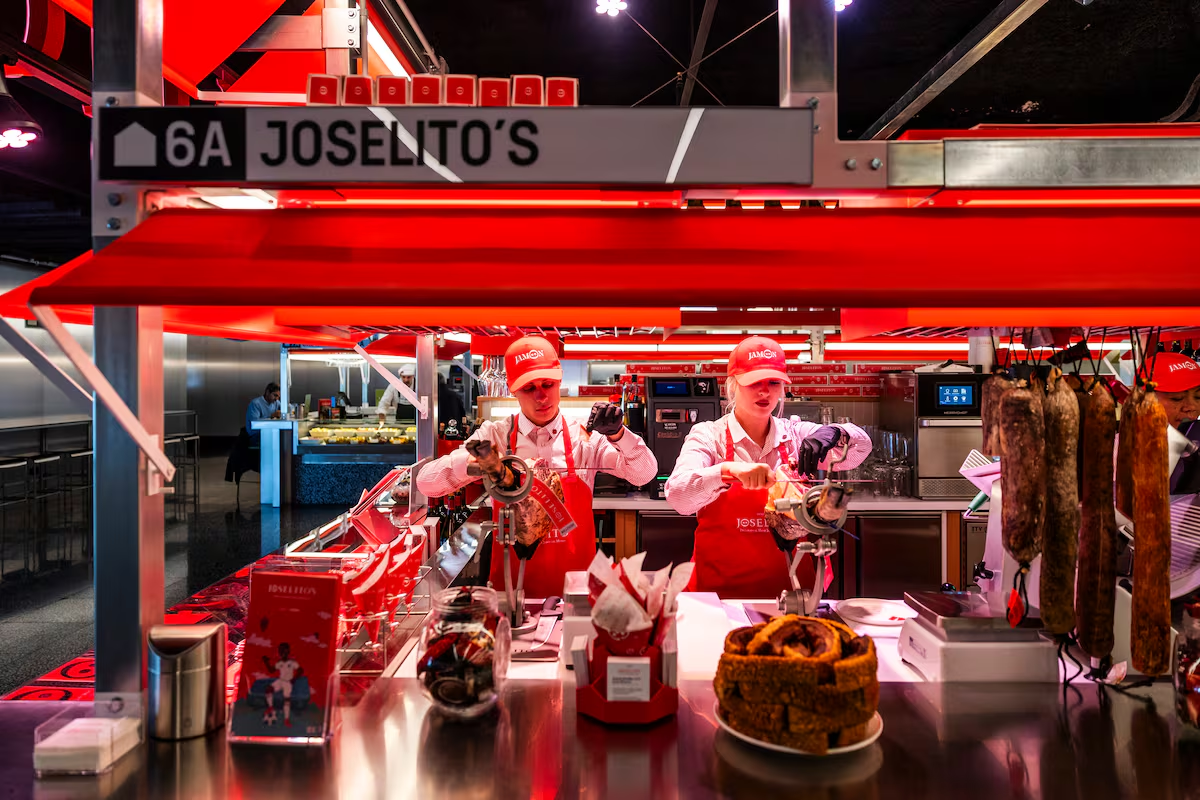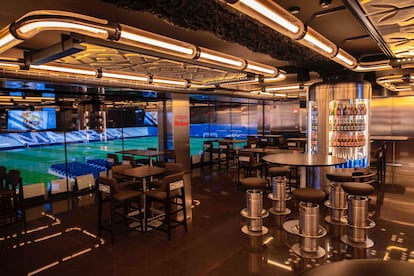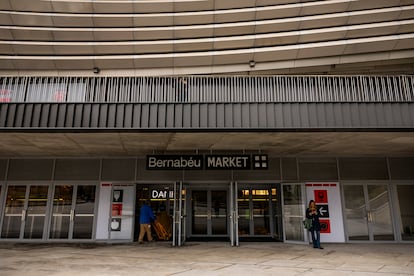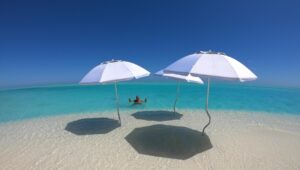
Starting this week, Madrid has a new gastronomic market: the Bernabéu Market. It is a 3,000 square meter space, under gate 45 of the stadium, which brings together – for the moment – 17 food stands, with the intention of reaching twenty in the coming weeks. The anticipation for this opening is high, like everything surrounding the Real Madrid sports facility, which has become a tourist icon of the city. According to data from the club’s latest report, presented to members, Real Madrid recorded a record number of 1,230,000 visitors during the 2023-2024 season (more than 4,000 people per day).
“The Bernabéu is an emblematic place, visited by as many people as those who go to the Prado Museum, and we had to be here. It is our first experience in a market with these characteristics”, explains Estíbaliz Pérez, partner of Perretxico, a group of taverns that belong to the Hirviendo group, originally from Vitoria. They have just opened a 30 square meter space to the public, with a counter where they offer an assortment of pinchos, including the star of the house: the Basque baked donut in two rolls (8.50 euros).
At the entrance, as soon as you cross the threshold, three promising spaces open up, with ham, churros and tortillas. The Iberian brand Joselito already offers hot consommé (4.5 euros), which will be served every day, together with the ham, cured meats, cheeks and prepared “good” torreznos, underlines one of the company’s cutters, Ernesto Soriano. “We are in the best stadium in the world, with powerful visibility and we come with the expectation that a lot of sandwiches will be sold,” he adds. The most iconic sandwiches, with bread from the Alma bakery, start from 9.5 euros. For the more daring, there is the ear of corn seasoned with spicy mayonnaise (12 euros); Gilda’s, with salchichón, piparra, anchovies and olives (12.5 euros); or pastrami, with pickle mayonnaise and melted cheese (17 euros).
A few meters away, Casa Dani, with one of the most celebrated tortillas in Madrid, has prepared a row of pans from which, according to the manager of the counter, Basilio Gómez, at least 400 pieces will come out per day (4.70 euros for the skewer; 17 euros for the whole one). “There’s a reason we’re in one of the most visited museums,” he says. Another attraction to attract people, even foreigners, are the churros (four units, 3 euros). “Tourists like them a lot; they always try traditional things,” says Juan Gabriel Gorracategui, fifth generation of the family founding Chocolatería 1902, the oldest in Madrid. For fans of the Juventus club, the counter offers a repertoire of pastries in homage to the cups won, the merengue shirt or the 10 of Modric and Mbappé (6 euros).
The market served as a pretext for the owners of Asador Imanol to create a new brand: Greta La Vinagreta, specializing in gildas (from 3.75 euros) and pickles, where they also serve salad (13.5 euros) and candied artichokes (4.5 euros).
Paco Gómez arrives from O Carballiño (Orense) with his stand A Feira and a signature dish: octopus (23 euros), which he cooks right there. In Beata Pasta, Jonathan Malacarne explains that the goal of the house – with the seal of the Baldoria group behind it – is to become a temple of Italian cuisine, with dishes such as the Margherita pizza (11.9 euros) or the fettuccine with Bolognese sauce (13.9 euros). Lovers of kebab They have their space in the Kebah!, where they don’t show the cylindrical pieces of meat, but serve it already cut and seasoned with their own sauces. “It’s not the typical Indian concept”, explain Leticia España and María Lezama, managers of the counter, satisfied with having launched two versions: classic chicken and spicy chicken (7.90 euros).

Next door is Divorare, a group with 17 stores in Spain specializing in Italian fast food, based on focaccias filled with mortadella, ham, salami or hazelnut cream (starting from 5.90 euros). At the adjacent kiosk, Manteca, they make burgers. destroy —prepared by flattening a meatball, in this case from Madrid and Ávila, directly on a hot griddle. They have a challenge: to serve a thousand units a day (starting from 13.45 euros).
A counter displays an assortment of oysters from Daniel Sorlut, producers from Normandy and Marennes-Oléron. They arrive at this new location after their success at the San Miguel market. “The type of customer will be similar to what we have and we know that people like oysters,” explains Luis Amor, manager of the counter. They sell them for 3.5 euros and can be accompanied with a glass of champagne. Nearby there is one of the most beautiful stalls in the market, with wheels of wine that hypnotise: The Wine Shop, which offers 40 references of wines (starting from 3.50 euros per glass), 20 of cheeses (a platter of five varieties, 20 euros) and a cheesecake, La Merengona.
At a large counter, filled with plates, chopsticks and soy bowls, the Japanese Kogumi proposal is served, with an offer that includes everything from prawn or oxtail gyoza (9.5 and 13 euros respectively), to ramen (14 euros) or grilled tuna skewers (5 euros). For those who prefer something quicker there are Malvón empanadas or Olsen sandwiches. The finishing touch is the nougat shop from 1880, where they serve an assortment of ice creams made with Jijona nougat (from €3.50).
Each stall has its own drink, although they have one in common: Mahou beer, which this year celebrates one year with its own space at the Bernabéu, in Plaza Mahou, where more than 800,000 people have already passed through. The space features a publicly visible microfactory, with an annual production capacity of 30,000 liters of its unfiltered variety.

The market, promoted by the Amicalia group through its subsidiary Restanina, involved an investment of eight million euros and has a ten-year concession. It remains open all year round, from 10am to 12am and until 1am on weekends, although on match days it will close two hours before and two hours after to serve the stadium’s VIP guests.
The Bernabéu also hosts other established gastronomic spaces, such as Puerta 57, from the La Maquina group; KŌ by 99 Sushi Bar, with access from door 39; and the Arzábal tavern, which is accessed from door 28. At the other end, the southern one, is what is so far the most representative Starbucks café in Spain: a 900 square meter venue, spread over two floors and with a panoramic view of the playing field, where coffee-based cocktails and limited batches of special beans are offered.






